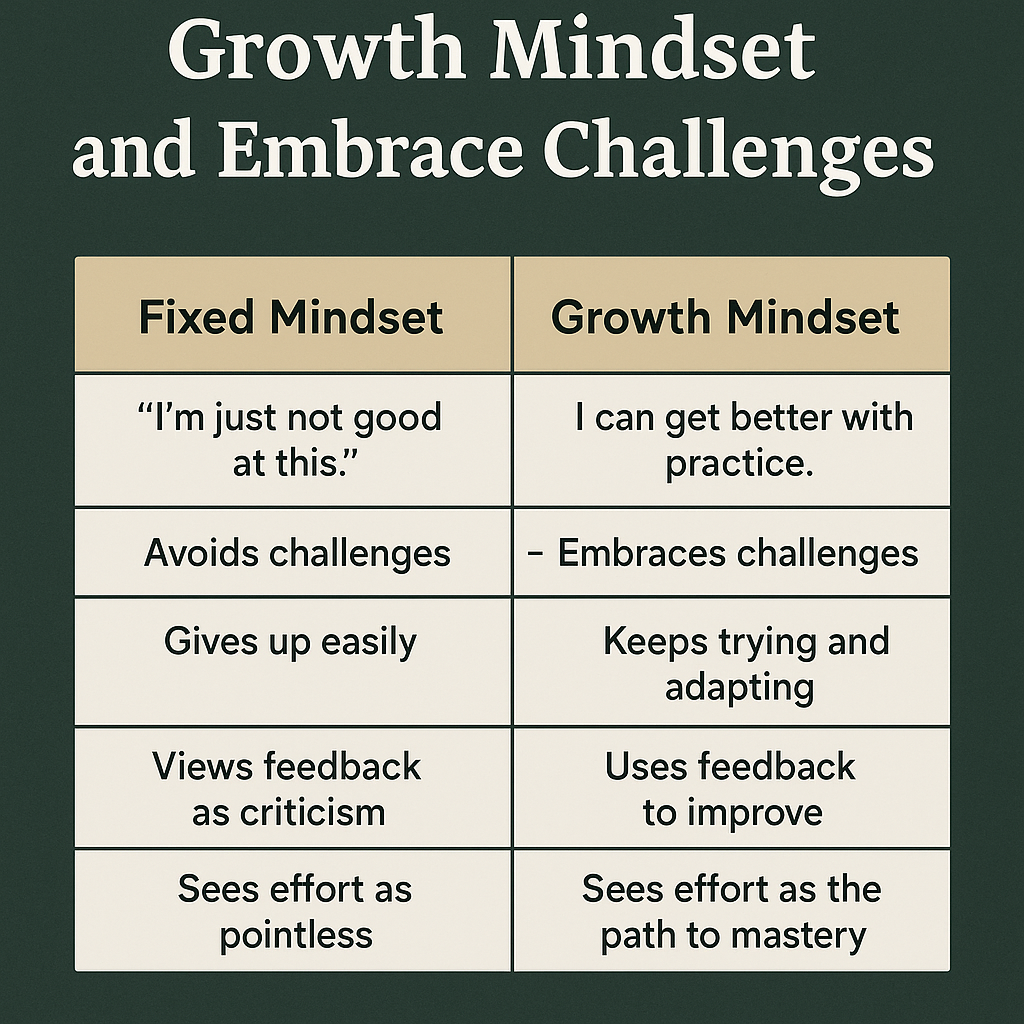Some people thrive in the face of obstacles. Others give up at the first sign of struggle. What makes the difference? It’s not talent—it’s mindset.
A growth mindset is the belief that your abilities can be developed through effort, learning, and resilience. In contrast, a fixed mindset assumes that intelligence or talent is static and unchangeable.
In this article, you’ll learn how to shift from a fixed to a growth mindset—and use challenges as fuel for personal development.
Fixed vs. Growth Mindset: What’s the Difference?
According to psychologist Carol Dweck, your mindset shapes how you approach learning, failure, and success.
| Fixed Mindset | Growth Mindset |
|---|---|
| “I’m just not good at this.” | “I can get better with practice.” |
| Avoids challenges | Embraces challenges |
| Gives up easily | Keeps trying and adapting |
| Views feedback as criticism | Uses feedback to improve |
| Sees effort as pointless | Sees effort as the path to mastery |
The good news? You can develop a growth mindset—even if you’ve had a fixed one for years.
1. Recognize Your Fixed Mindset Triggers
We all have areas where we slip into fixed thinking. The first step to change is awareness.
Ask yourself:
- When do I feel threatened by failure or comparison?
- Do I avoid trying new things out of fear of looking “bad”?
- Do I believe I either “have it” or “don’t”?
Write these triggers down. Naming them helps you reclaim power over them.
2. Reframe Failure as a Learning Tool
Failure is not the opposite of success—it’s part of it. Every mistake holds valuable information.
Try these reframes:
- “This didn’t work” → “What can I learn from this?”
- “I failed” → “I’m still learning”
- “I’m bad at this” → “I haven’t mastered this yet”
The word yet is powerful. It turns a limitation into a possibility.
3. Focus on the Process, Not Just the Outcome
Growth mindset is built through attention to how you do things—not just the results.
Celebrate:
- Showing up even when you didn’t feel like it
- Improving your skills through repetition
- Learning from feedback
- Finishing a tough task, even if it wasn’t perfect
Progress isn’t always visible—but it’s happening beneath the surface.
4. Surround Yourself With Growth-Minded People
Mindset is contagious. Spend time with people who:
- Encourage learning and curiosity
- Share openly about failure and growth
- Value effort over perfection
- Challenge you to improve (without judgment)
Limit time with those who constantly complain, blame, or compare. You become like the people you’re around most.
5. Learn to Love the Challenge
A true growth mindset welcomes discomfort—it’s where transformation happens.
Next time you face something difficult:
- Say: “This is how I grow.”
- Focus on the skills you’re building, not the stress
- Break it down into manageable steps
- Track your progress and effort (not just results)
Confidence doesn’t come from ease. It comes from overcoming.
6. Practice Daily Growth Mindset Habits
Like any skill, mindset needs reinforcement.
Try:
- Writing “What did I learn today?” in your journal
- Using affirmations like “I’m always learning and improving”
- Reading books or listening to podcasts that promote resilience and learning
- Reflecting weekly on how you handled challenges
Growth mindset isn’t a one-time switch—it’s a lifestyle.
Final Thought: You’re Not Stuck—You’re Still Becoming
Your brain is capable of change. Your skills, character, and mindset are all malleable. You are not defined by your past or limited by your present.
The next time something feels hard, ask yourself:
“How can this help me grow?”
That question will take you farther than talent ever will.

